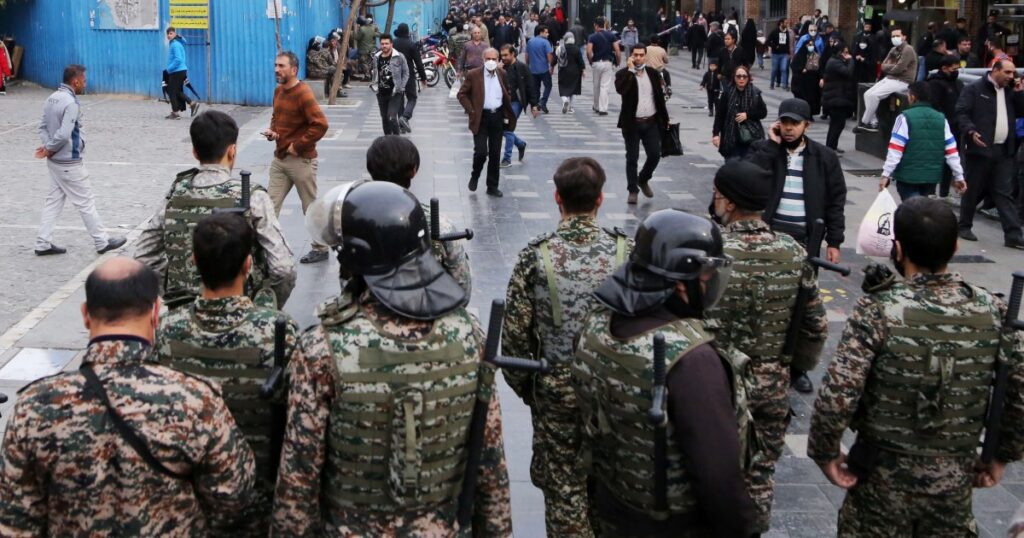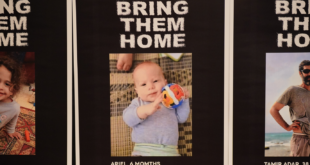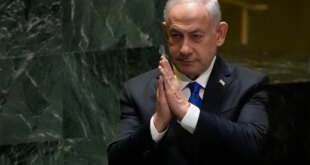
With Iran’s protests extending into a third month, the government’s crackdown is intensifying in ethnically Kurdish areas in the northwest of the country, according to the government, local officials and human rights activists.
At least 42 people have been killed over the past week while protesting in Kurdish cities as a result of “direct fire from the Iranian government forces,” Kurdish human rights group Hengaw said Tuesday. The group, which focuses on human rights in Iranian Kurdistan, said that at least 1,500 people have been injured.
Authorities restrict media coverage of demonstrations, making independent reporting on protests difficult if not impossible. NBC News cannot verify claims made by the government or independent organizations.
Two videos NBC News was able to confirm were filmed in Javanrud, in Kermanshah province, an area with a high proportion of ethnic Kurds, showing clashes on a rubble-strewn street. One video was shot from the perspective of men wearing camouflage worn by Islamic Revolutionary Guard Corps, a powerful military and political force with deep influence in the Iranian state. The other was filmed from the perspective of civilians in plain clothes who are carrying no visible weapons.
In the clashes Hengaw said occurred Monday, gunfire can be heard as the armed, camouflage-clad men advance up the street toward the people in plain clothes.

According to the semi-official Fars news agency, the violence broke out Monday after two funerals had been held in the city. The regime-aligned agency blamed the violence on “rioters” and “Kurdish separatists” who infiltrated crowds of protesters and attacked an IRGC base. The Guards “started shooting in the air but had to resort to shooting at the attackers,” Fars resported, adding that several officers were injured and two had their houses set on fire.
Mohammad Kowsari, a former commander of the IRGC who is now a hard-line lawmaker, said Iran has sent the army to the region to fight Kurdish separatist groups. He was speaking in an interview that appeared on Jamaran, a website with close links to Islamic Republic’s founder, Ayatollah Ruhollah Khomeini.
Jalal Mahmoudzadeh, a member of Parliament for Mahabad, told the Etemad newspaper that members of the security forces had fired upon homes and businesses Saturday, calling on authorities to soften their approach, according to Reuters.
On Wednesday, the United States imposed sanctions against three Iranian security officials for allegedly helping in spreading military control over predominantly Kurdish areas that it said have “faced a particularly severe security response” since the protests began in September.
Iranian officials have blamed much of the violence in the northwest on people it refers to as terrorists or Kurdish separatists, without offering evidence for those claims. Local security official Mohammad Pourhashemi told state TV that local gunmen were responsible for the violence in Javanrud after exchanging fire with security forces.
Some Kurdish groups have been engaged in a low-intensity conflict with Iran since the country’s Islamic revolution in 1979. Iran accuses them of inciting protests and smuggling weapons into the country, allegations the Kurds have denied.
The violence in Kurdish areas is just one of several moving parts in the widespread display of dissent, often led by women, against the semi-theocratic authoritarian regime that has ruled Iran since 1979.
“There’s a lot going on,” said Sanam Vakil, a deputy director specializing in Iran at the London think tank Chatham House.
Mahsa Amini, the young woman whose detention by morality police and subsequent death three days later sparked deadly nationwide protests, was Kurdish. Authorities deny mistreating her.
The demonstrations originated in the Western Kurdish region but have since spread across the country, which is around the size of Alaska and whose 85 million people outnumber the populations of California and Texas combined.
On the ground, protests for women’s rights have morphed into a wider and more diverse movement. Some protesters have called for an overthrow of the regime and “death to the dictator” — meaning Iran’s supreme leader, Ayatollah Ali Khamenei.
Younger protesters — often horrified at Amini’s death after her arrest for allegedly breaking Iran’s strict dress code laws — have been unafraid to target sacred symbols of the Islamic Republic. Videos of people knocking the turbans off the heads of religious figures have gone viral, one of which was geolocated by NBC News to Tehran’s metro system. Last week, protesters set a fire at the ancestral home of Khomeini himself, activists say .
“Today, the young in particular are disruptors and they want to change the status quo by pushing back against social, cultural, political norms and red lines that had previously limited engagement between state and society,” Vakil said.
These “brazen acts” show “their level of profound anger in the face of leadership that has known about popular frustration but done nothing to address it,” she added.
These domestic protests exploded onto the international stage after the Iran men’s soccer team did not sing the national anthem during its first World Cup match against England in Qatar on Monday.
Ehsan Hajsafi, Iran team’s captain, became the latest public figure to suggest support for the protesters. “We have to accept that the situation in our country is not good and ttehat our people are not happy,” he said during a news conference.
On Thursday, the semi-official agency Tasnim News reported that national football player Voria Ghafouri, who was not chosen to go to the World Cup, was arrested on charges of insulting and damaging the image of Iran National Football Team and propaganda against the government.
The violence has also spilled across the border into Iraq, which like other neighboring countries also has a Kurdish region.
Iran blames its domestic unrest partly on Iraqi Kurdish groups, and has targeted them with missile and drone attacks. These have been condemned by Kurdish officials and the Iraqi government, despite the latter being dominated by parties close to Iran.
Last week, Esmail Ghaani, the commander of Iran’s elite Quds Force, visited Baghdad and threatened Iraq with a ground invasion in the country’s north if it did not fortify the border.
Source link
 Latest World Breaking News Online News Portal
Latest World Breaking News Online News Portal







